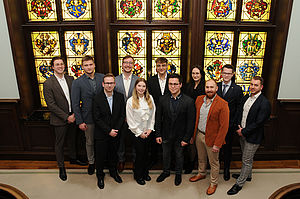(22.02.2023) Im Rahmen einer Feierstunde im ehrwürdigen Haus Schütting verabschiedeten der Bremer Rhederverein e.V., die Schiffsmaklervereinigung für Küsten- und Seeschiffsbefrachter e.V. und der Verband Hamburger und Bremer Schiffsmakler e.V. am Mittwoch nach einer längeren COVID-Pause gemeinsam die erfolgreichen Schifffahrtskaufleute. Den aktuellen Prüfungsdurchgang konnten 16 junge Menschen erfolgreich absolvieren. Es überwogen erneut die Vertreter der Linien. 13 Prüflinge hatten den Schwerpunkt „Linien“, nur drei ließen sich im Schwerpunkt „Tramp“ prüfen. Mit dem besten Gesamtprüfungsergebnis erklomm Lucas Leonard Kladenhoff (MSC Germany S.A. &) den 1. Platz. Auf Platz 2 folgt Johanna Schröter (Orient Overseas Contai-ner Line Ltd.) und Platz 3 belegt Stina Sari (Peter W. Lampke GmbH & Co. KG).
Die Verbände nutzen die Gelegenheit nicht nur um den frisch gebackenen Kollegen und Kolleginnen zu gratulieren, sondern würdigten auch die Arbeit der Ausbildungsverantwortlichen in den Betrieben sowie des Lehrkörpers an der Berufsschule. Beides seien wichtige Beiträge zum Erhalt der Wettbewerbsfähigkeit des Standortes. Der Zugang zu qualifiziertem Personal sei ein nicht zu unterschätzender Faktor im Wettbewerb mit anderen Hafen- und Schifffahrtsstandorten. Die Ausbildung von Schifffahrtskaufleuten sei daher auch als Teil der Standortpolitik verstehen, damit sich Bremen im Wettbewerb gegenüber anderen Häfen- und Schifffahrtsstädte behaupten könne. Aus Sicht der Verbände müsse die Tatsache, dass in Bremen und Bremerhaven qualifiziert und hochwertig ausgebildet wird, noch viel stärker in die Standortvermarktung einfließen.
Wir wünschen allen Prüflingen alles Gute für den weitere Lebensweg.
